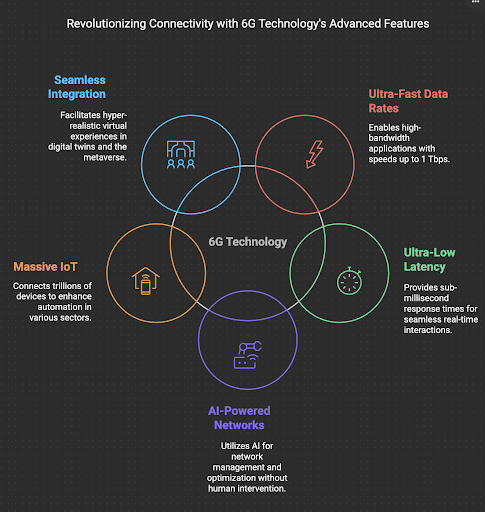6G Technology: The Next Leap in Wireless Connectivity

Last updated: 27 May 2025
Written by: Circles.Life
13 minutes read
The Evolution Toward 6G
Brief History of Mobile Network Evolution (1G to 5G)
Why 6G is the Next Logical Step
Expected Rollout Timeline (2030 and Beyond)
What is 6G?
Key Enablers of 6G
The Game-Changing Features of 6G
Industries That Will Benefit the Most from 6G
Challenges and Roadblocks
The Road Ahead: What to Expect by 2030
Research Initiatives Driving 6G Development
How Businesses and Consumers Can Prepare for 6G
Start Preparing for the 6G Future
Frequently Asked Questions
The Evolution Toward 6G
Mobile technology has changed the way we live, work, and connect with each other. From simple voice calls in the 1980s to today’s high-speed streaming and smart devices, every generation of wireless networks has opened new doors.
Now, the world is starting to talk about what's next: 6G. While it might sound futuristic, it’s already in development. And it's not just about faster speeds. 6G will support smarter, more connected experiences that go beyond what we can do today. Think of things like real-time holograms, fully autonomous systems, and seamless communication between people and machines.
In this guide, we’ll explore where we’ve been, what’s coming with 6G, and how it could shape the future.
Brief History of Mobile Network Evolution (1G to 5G)

To understand the promise of 6G, it helps to look back at how far mobile networks have come. Each generation has brought major improvements, changing the way we use technology in everyday life.
1G (1980s): This was the beginning of mobile communication. Phones could make analog voice calls, but the sound quality was poor and coverage was limited.
2G (1990s): Things got better with digital voice, better call quality, and the introduction of SMS. Text messaging became a big part of how people communicated.
3G (2000s): This was a game-changer. For the first time, we had real access to the internet on mobile devices. Video calls and email on the go became possible.
4G (2010s): Mobile networks took a huge leap with fast internet speeds. Streaming videos, using mobile apps, and even remote work became the norm.
5G (2020s): Today’s latest network brings ultra-fast speeds and extremely low latency. It powers smart homes, connected cars, and supports the growing Internet of Things (IoT).
Each generation has built the foundation for the next. Now, 6G is expected to take things even further by combining speed, intelligence, and connectivity in ways we've never seen before.
Why 6G is the Next Logical Step
As powerful as 5G is, the demand for even faster, smarter, and more responsive technology is already pushing the boundaries. 6G is being developed to meet those growing needs and unlock experiences that current networks simply can’t handle.
Deliver Ultra-Low Latency for Real-Time Interactions
6G is expected to reduce latency to almost zero. This means data will travel so fast that interactions can happen in real time. For things like remote surgery, autonomous vehicles, or multiplayer gaming, this level of responsiveness can make all the difference.
Support AI-Powered Networks for Self-Optimizing Connectivity
Unlike today’s networks, 6G will be designed to work hand in hand with artificial intelligence. These networks will be smart enough to manage themselves, adjusting traffic, optimizing performance, and learning how to deliver better service over time.
Enable Immersive Applications Like Holographic Communication
Think beyond video calls. With 6G, fully immersive experiences like 3D holograms or mixed reality could become part of everyday life. From virtual meetings that feel real to interactive learning environments, the possibilities are wide open.
Expected Rollout Timeline (2030 and Beyond)
While 6G is still in its early stages, development is already in motion. Researchers, tech companies, and governments around the world are laying the groundwork to bring 6G to life.
Research and Development Are Already Underway
Major telecom companies and research institutions have started exploring 6G technologies. They're testing ideas, setting goals, and identifying the technical challenges that need to be solved.
Standardization Expected Between 2025 and 2028
Before 6G can be deployed, global standards need to be agreed upon. This process ensures that devices and networks work together across countries and brands. Experts expect these standards to be finalized sometime between 2025 and 2028.
Commercial Rollout Projected for 2030
If all goes as planned, the first commercial 6G networks could be launched around 2030. Early versions may appear in tech-forward cities first, with broader adoption following in the years after.
What is 6G?
6G is the upcoming sixth generation of wireless communication technology. While 5G is still being rolled out across the world, 6G is already being developed to meet the future’s growing demand for speed, intelligence, and connectivity. It’s not just a faster version of 5G—it’s expected to completely transform how devices, networks, and people interact.
How 6G Differs from 5G
Here’s a quick comparison of what we use now versus what 6G is expected to deliver:
6G will go far beyond phones and internet browsing. It’s expected to connect everything from smart cities to autonomous systems in real time, with intelligence built directly into the network.
Key Enablers of 6G
To make 6G a reality, several advanced technologies will need to work together. These are the core innovations that will power the next generation of wireless networks:
AI and Machine Learning
6G networks won’t just transmit data—they’ll be smart enough to manage and optimize themselves. Artificial intelligence will help the network adjust in real time, predict demand, and improve performance without human input.
Terahertz (THz) Frequencies
6G is expected to operate on terahertz spectrum bands, which can carry massive amounts of data at incredibly fast speeds. This will support ultra-high-definition content, real-time holograms, and other data-heavy applications.
Quantum Computing
With 6G aiming for extreme speeds and security, quantum computing could help strengthen encryption and protect user data against increasingly complex cyber threats.
Edge Computing
Edge computing brings data processing closer to the devices that use it. For 6G, this means faster response times, better performance for apps, and reduced strain on central servers.
Together, these technologies will make 6G smarter, faster, and more efficient than anything we’ve seen before.
The Game-Changing Features of 6G

6G won’t just be a small step up from 5G—it’s expected to change the way we experience the digital world. Here are some of the standout features that make 6G so exciting:
Ultra-Fast Data Rates
With speeds projected to reach 100 Gbps to 1 Tbps, downloading massive files or streaming ultra-HD content could take just seconds. This opens the door for real-time cloud computing, large-scale AI applications, and next-level entertainment.
Ultra-Low Latency
6G aims to reduce latency to less than 1 millisecond. This near-instant responsiveness will make things like remote surgeries, autonomous driving, and robotic collaboration more reliable and precise.
AI-Powered Networks
6G will integrate artificial intelligence directly into the network. This means self-learning systems that can monitor, adapt, and optimize themselves without human intervention—ensuring smoother, more efficient performance.
Massive IoT
6G will support billions of connected devices all at once. From smart homes and wearables to connected infrastructure in cities, the network will be ready for large-scale, data-rich environments.
Seamless Integration with Digital Twins and the Metaverse
6G is expected to bring advanced technologies like digital twins (virtual replicas of real-world systems) and immersive AR/VR to life. These experiences will feel more real and responsive, making them more useful in areas like education, healthcare, and design.
Industries That Will Benefit the Most from 6G
6G won’t just be a tech upgrade—it will unlock major opportunities across a wide range of industries. Here’s a look at where 6G is expected to make the biggest impact:
From medical breakthroughs to more immersive entertainment experiences, 6G is expected to fuel innovation across sectors that touch everyday life.
Challenges and Roadblocks
As promising as 6G sounds, getting there won’t be easy. Several technical, financial, and regulatory obstacles need to be addressed before 6G becomes a part of our daily lives.
Infrastructure and Investment Costs
Building out a 6G network will require new hardware, fiber infrastructure, and upgraded devices. The cost of this transition will be high, especially for smaller or developing regions.
Regulatory Hurdles and Spectrum Allocation
6G is expected to operate on terahertz frequencies, which aren’t currently assigned for commercial use in most countries. Governments and international bodies will need to coordinate and define how spectrum is shared and regulated.
Energy Consumption and Sustainability Concerns
More powerful networks often mean more energy usage. To make 6G sustainable, engineers and tech companies will need to find ways to reduce its environmental footprint without compromising performance.
Security and Privacy Risks
With billions of devices connected and networks powered by AI, 6G will need advanced security systems. Protecting user data, preventing cyberattacks, and building trust in AI-powered networks will be essential.
The Road Ahead: What to Expect by 2030
The path to 6G is already taking shape, with major players in tech and telecom investing heavily in research and early testing. While full deployment is still a few years out, there are already signs of what’s coming.
Ericsson
Ericsson is focusing on building AI-driven networks that can manage themselves, adapt to changing conditions, and deliver consistently strong performance.
Nokia
Through its 6G Flagship project, Nokia is working with global research teams to explore use cases, set technical standards, and shape the future of wireless connectivity.
Samsung
Samsung is leading the way in THz spectrum testing, aiming to overcome one of the biggest technical challenges of 6G making ultra-high-frequency waves usable in real-world conditions.
Huawei
Huawei is investing in AI-powered connectivity solutions to support large-scale 6G adoption, with a focus on speed, automation, and security.
By 2030, we’re likely to see the first wave of 6G-enabled products and services, starting in innovation hubs and expanding globally as the technology matures.
Research Initiatives Driving 6G Development
The journey to 6G isn’t just being led by private companies—governments and academic institutions are also playing a big role in pushing the technology forward. Here are two major research initiatives to know about:
Hexa-X (European Union)
Hexa-X is a large-scale research project supported by the European Union. Its goal is to define the most promising 6G use cases, develop new network technologies, and create a roadmap for rollout. The project brings together a wide group of partners, including Nokia, Ericsson, and leading universities.
6G Flagship (Finland)
Based at the University of Oulu in Finland, the 6G Flagship program is one of the world’s most active research hubs for next-generation wireless technologies. It focuses on key areas like energy efficiency, data security, and new applications for 6G in real-world environments.
These efforts are helping shape what 6G could look like and ensure the technology meets real needs, not just theoretical ones.
How Businesses and Consumers Can Prepare for 6G
While 6G may still be several years away, there are steps you can take today to be ready for what’s coming. Preparing now means you’ll be better positioned to adopt the technology when it arrives and to take advantage of its full potential.
Stay Informed
Keep an eye on 6G updates from trusted sources like research projects, telecom companies, and government announcements. Following developments will help you understand how 6G may impact your industry or daily life.
Invest in 5G Infrastructure
For businesses, upgrading to 5G now can lay the foundation for 6G later. Many of the systems that will support 6G—like AI-driven tools and edge computing—are already being used in advanced 5G setups.
Embrace AI and Edge Computing
6G will rely heavily on artificial intelligence and real-time data processing. Businesses that begin using AI and edge computing tools today will have a head start when 6G makes these technologies even more powerful and accessible.
Start Preparing for the 6G Future
6G is more than just the next step in mobile technology. It’s a major shift that will shape the future of communication, business, and daily life. From ultra-fast speeds to intelligent networks and immersive digital experiences, 6G has the potential to change how we live and work.
Now is the time to start preparing. Whether you're a tech enthusiast, a business leader, or simply curious about what's next, staying informed will help you make smarter decisions down the line.
Follow the latest research, watch what the major players are doing, and begin exploring the tools that will power tomorrow’s world.
Frequently Asked Questions
1. When will 6G be available?
6G is expected to roll out commercially around 2030. Research and testing are already in progress, and global standardization efforts are planned between 2025 and 2028.
2. How fast will 6G be?
6G could deliver speeds between 100 Gbps and 1 Tbps, making it significantly faster than 5G. That means ultra-quick downloads, near-instant responses, and support for data-heavy applications like holograms and immersive VR.
3. Will 6G replace 5G?
Eventually, yes but not right away. 6G will build on what 5G has started. For many years, both networks will likely work together, especially as industries and consumers gradually make the shift.
4. How will 6G impact everyday life?
6G could change the way we experience the world. It will support smarter cities, real-time health monitoring, immersive learning, and more efficient business operations. Things that seem futuristic now like holographic calls or autonomous transportation could become part of everyday life.
Share
RECOMMENDED
Step-by-step guide to calling a Hong Kong landline or mobile: Dial 001-852-Area Code-Landline or 001-852-8-digit Mobile Number.
Compare the best SIM-Only plans in Singapore. Discover the cheapest, family-friendly, and most data-packed options for all mobile data users.
Discover the top foldable phones of 2025 from Samsung, Apple, Oppo & more. Compare features, display, and performance for buyers in Singapore.

Want more?
Subscribe to our newsletter and get notifications when there’s more to read!
By submitting your details, you consent to us sending you promotional and marketing updates. Please read our Privacy Policy for more information.